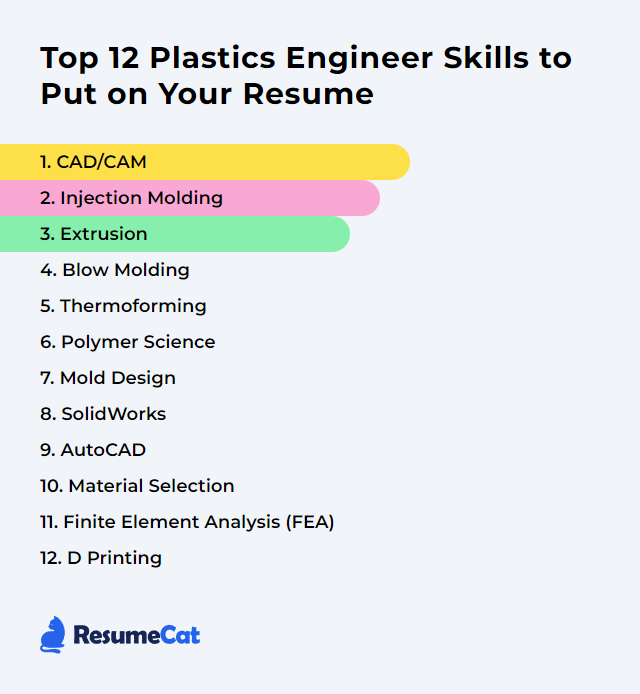Top 12 Plastics Engineer Skills to Put on Your Resume
In plastics engineering, your resume has to do more than list job titles. It should reflect sharp technical depth and practical judgment, plus the soft skills that keep projects humming. The right skills, shown clearly, can tip the scales fast.
Plastics Engineer Skills
- CAD/CAM
- Injection Molding
- Extrusion
- Blow Molding
- Thermoforming
- Polymer Science
- Mold Design
- SolidWorks
- AutoCAD
- Material Selection
- Finite Element Analysis (FEA)
- 3D Printing
1. CAD/CAM
CAD/CAM (Computer-Aided Design/Manufacturing) covers the full loop from modeling parts and tooling to programming the machines that make them. For plastics engineers, that means clean models, mold-ready features, and toolpaths or process plans that hit tolerance and cycle time targets.
Why It's Important
It turns ideas into manufacturable parts with precision and speed. Better fits, fewer reworks, faster launches. And it stitches design and production together so feedback actually sticks.
How to Improve CAD/CAM Skills
Focus on the essentials that move quality and throughput:
Keep software current: New releases often add surfacing, draft checks, and automation that shave hours.
Train with intent: Target plastics-specific workflows—mold parting, draft, ribs, living hinges, split lines.
Integrate data: Tie CAD/CAM to PLM/ERP/MES so revisions, BOMs, and work instructions stay in sync.
Simulate early: Validate flow, warpage, cooling, and toolpaths before steel gets cut.
Automate: Use templates, design tables, macros, and APIs for repetitive geometry and setups.
Close the loop: Feed shop-floor findings back into models—tolerances, venting tweaks, gate moves.
Learn from peers: Engage with engineering communities and user groups for tricks and hard-won lessons.
Do this, and your CAD/CAM work becomes faster, cleaner, and easier to scale.
How to Display CAD/CAM Skills on Your Resume

2. Injection Molding
A high-volume process that injects molten polymer into a mold, then cools and ejects precise, repeatable parts. The workhorse for complex geometry at scale.
Why It's Important
It delivers tight tolerances, clean surfaces, and consistency at speed. Critical when timelines are short, costs matter, and quality can’t wobble.
How to Improve Injection Molding Skills
Dial in the science and the discipline:
Material selection: Match resin to loads, environment, aesthetics, and regulatory needs. Know melt flow, shrinkage, moisture sensitivity.
Mold design: Balance cooling, optimize gating, vent thoroughly, and plan robust ejection. Conformal cooling where it counts.
Process optimization: Use scientific molding with DoE to lock in filling, pack/hold, and cooling. Record and control the window.
Maintenance: Keep machines and tooling clean, aligned, and lubricated. Prevent wear, don’t chase it.
Training: Cross-train operators and engineers—data-driven setups, decoupled molding, troubleshooting.
Quality control: Inspect dimensions and appearance, monitor trends, react before defects multiply.
Result: shorter cycles, fewer rejects, steadier throughput.
How to Display Injection Molding Skills on Your Resume
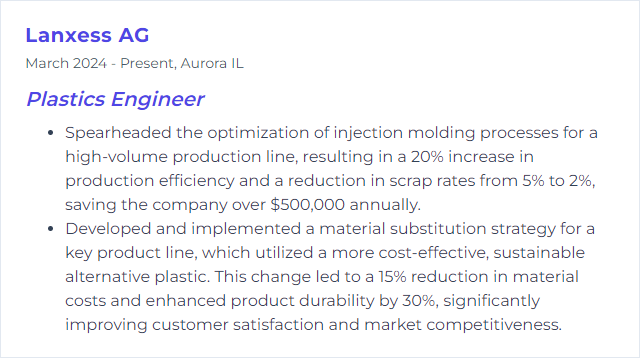
3. Extrusion
Plastic is melted and pushed through a die to form continuous profiles—sheet, film, tubing, or custom shapes—then cooled and sized.
Why It's Important
It’s efficient, scalable, and flexible. Complex profiles, steady dimensions, long runs that hit cost targets.
How to Improve Extrusion Skills
Stability is king. So is uniformity:
Material prep: Dry and blend consistently. Control moisture and fillers for predictable melt behavior.
Equipment care: Inspect screws, barrels, dies, and downstream gear. Wear shows up as variability.
Process tuning: Match screw design, temperature profile, screw speed, and feed to the resin and product.
Die design: Ensure even flow distribution and minimal pressure drop. Balance is everything.
Cooling and sizing: Uniform, well-controlled cooling locks in dimensions and properties.
Quality monitoring: Track thickness, width, surface quality, and mechanicals in real time.
Team competency: Train operators on changeovers, stabilization routines, and fault isolation.
This tightens tolerances and reduces scrap, plain and simple.
How to Display Extrusion Skills on Your Resume
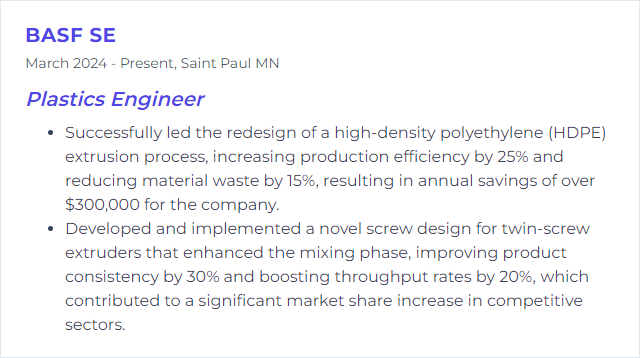
4. Blow Molding
Produces hollow parts by inflating a heated parison inside a mold until it matches the cavity. Common for bottles, tanks, and containers.
Why It's Important
It makes lightweight, robust hollow shapes at scale with consistent walls and efficient material use.
How to Improve Blow Molding Skills
Tight control delivers uniform parts:
Resin choice: Select grades with melt strength and barrier properties that fit the application.
Mold design: Engineer for even wall thickness, smart parting lines, and efficient cooling.
Process control: Stabilize heat, pressure, parison programming, and cooling to improve repeatability.
Real-time monitoring: Use inline measurement and inspection to catch drift early.
Upskill the team: Share best practices on trimming, deflashing, leak testing, and changeovers.
That combination cuts waste and locks in quality.
How to Display Blow Molding Skills on Your Resume
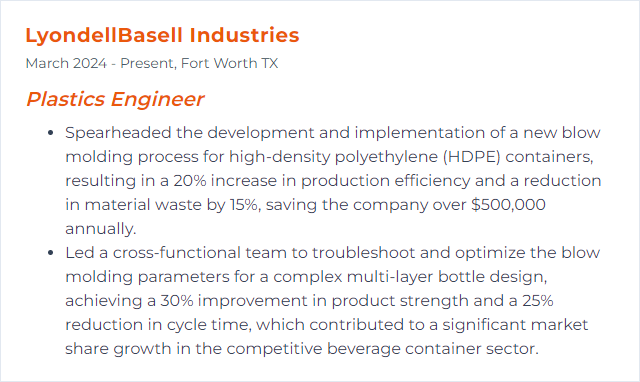
5. Thermoforming
A heated plastic sheet is shaped over or into a mold and then trimmed into a finished part. Quick, clean, and cost-effective for many geometries.
Why It's Important
Great for rapid prototypes and production alike. Lower tooling costs, fast iterations, and large, lightweight parts with crisp details.
How to Improve Thermoforming Skills
Consistency begins with heat and ends with trim:
Material selection: Pick sheet with the right thickness distribution and forming window for the end use.
Mold design: Add draft, vent well, and simulate draw to prevent thinning and webbing.
Heating control: Zone heaters for uniform temperature; monitor emissivity and sheet response.
Process control: Standardize cycle timing, vacuum/pressure levels, and pre-stretch where needed.
Cooling and trimming: Optimize cooling fixtures, then use precise trimming to reduce rework and cycle time.
Sustainability: Regrind responsibly, spec recyclable materials, and minimize offcuts with nesting.
Good discipline here returns faster cycles and fewer defects.
How to Display Thermoforming Skills on Your Resume
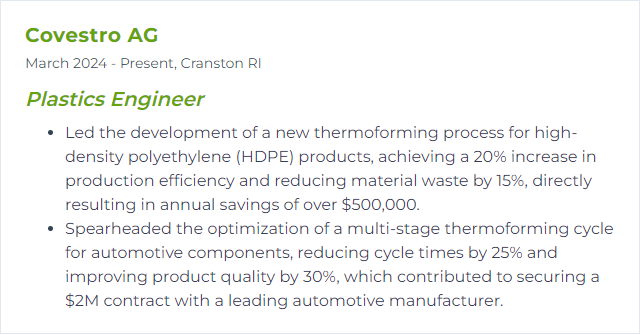
6. Polymer Science
The backbone of plastics: how polymers are made, structured, processed, and how they behave. From chemistry to mechanics to end-of-life.
Why It's Important
It links structure to performance. With it, you can tailor materials, predict behavior, and push designs that last longer and tread lighter.
How to Improve Polymer Science Skills
Build breadth, then go deep:
Stay current: Read journals, attend seminars, and track advances in biopolymers, additives, and recycling.
Lab time: Run tests—DMA, DSC, rheology, impact—so data informs choices.
Advanced study: Pursue targeted courses in polymer synthesis, processing, and characterization.
Network: Join professional groups and conferences to compare approaches and benchmark.
Design for sustainability: Understand recyclability, degradation, carbon impacts, and regulatory requirements.
Connect to processing: Tie material behavior to molding, extrusion, and forming outcomes.
The payoff is smarter material choices and fewer surprises in production.
How to Display Polymer Science Skills on Your Resume
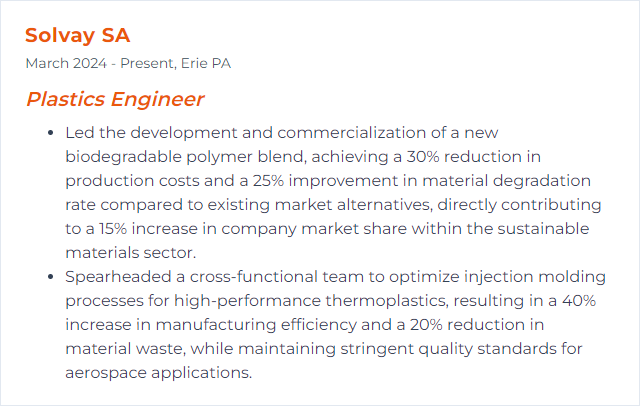
7. Mold Design
Turning part geometry into steel that runs fast and clean. Gate strategy, cooling, venting, steel selection, and ejection all working in concert.
Why It's Important
Mold design decides cycle time, part quality, and tool life. Good design cuts defects, warpage, and maintenance headaches before they start.
How to Improve Mold Design Skills
Think flow, then think cooling, then think serviceability:
Flow analysis: Simulate filling, packing, cooling, and warpage to validate decisions upfront.
Cooling optimization: Use balanced circuits and consider conformal cooling for tough hotspots.
Surface and coatings: Specify finishes and treatments that improve release and resist wear.
Modularity: Design inserts and standardized components for faster maintenance and revisions.
Tool steels: Match steel to resin abrasiveness, corrosion risk, and expected volumes.
Venting: Place vents to avoid burns and shorts; keep them service-friendly.
New manufacturing methods: Use additive for complex channels or quick-turn inserts when justified.
Gate placement: Minimize knit lines, mark-off, and stress by gating smartly and validating with analysis.
Strong molds make stable processes. Everything flows from there.
How to Display Mold Design Skills on Your Resume
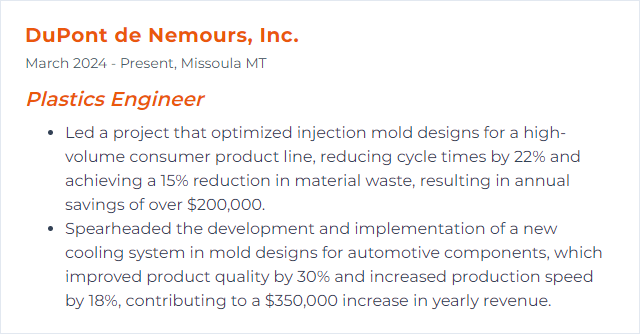
8. SolidWorks
A 3D CAD platform widely used to design plastic parts, assemblies, and molds, with tools for draft, split lines, and flow-driven checks.
Why It's Important
It enables fast iteration, accurate drawings, and simulation-driven decisions that reduce tooling changes and scrap.
How to Improve SolidWorks Skills
Target plastics-focused capability:
Mold tools: Master parting lines, shut-offs, cores/cavities, and check for draft and undercuts.
Simulation for plastics: Use molding and cooling analysis to predict fill patterns and hotspots.
Advanced surfacing: Build smooth, complex Class-A surfaces for consumer-facing parts.
Certification: Earn credentials that prove skill with assemblies, surfacing, and modeling speed.
Community: Learn power-user workflows, shortcuts, and macros from experienced users.
Stronger modeling chops directly translate to cleaner tooling and faster launches.
How to Display SolidWorks Skills on Your Resume
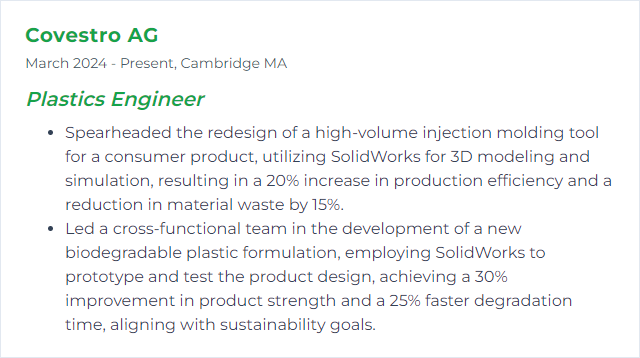
9. AutoCAD
Go-to software for precise 2D and 3D drawings of components, tooling, jigs, and plant layouts. Crisp geometry, clear communication.
Why It's Important
It streamlines design intent and documentation, reducing ambiguity between engineering, tooling, and production.
How to Improve AutoCAD Skills
Make it faster and more exact:
3D modeling: Build confidence with solids and surfaces for fixtures and mold components.
Materials context: Know plastics behavior to reflect real-world manufacturability in your drawings.
Customization: Create scripts, blocks, and tool palettes tailored to your standard practices.
Stay updated: New releases often include drafting automation and performance gains.
Community learning: Share techniques and troubleshoot complex detailing with peers.
The result is quicker detailing and fewer interpretation errors downstream.
How to Display AutoCAD Skills on Your Resume
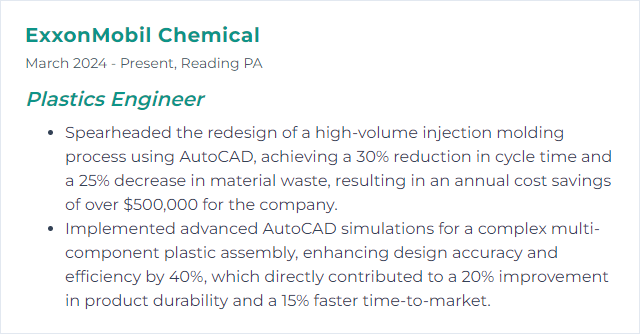
10. Material Selection
Choosing the right polymer for the job by weighing mechanical, thermal, chemical, environmental, processing, and cost constraints.
Why It's Important
The resin governs performance, durability, and compliance. Pick well and manufacturing is smoother, costs drop, and reliability holds up.
How to Improve Material Selection Skills
Be systematic and evidence-driven:
Define requirements: Loads, temperature, chemicals, UV, impact, wear, regulatory and safety.
Compare properties: Use trusted data for modulus, toughness, creep, fatigue, and shrinkage.
Account for environment: Consider recyclability, carbon footprint, and end-of-life pathways.
Balance cost: Pair price with performance, tooling demands, and expected volumes.
Follow standards: Align with relevant specs and certifications for your market.
Model and test: Simulate performance, then prototype to confirm assumptions.
Consult experts: Lean on suppliers and specialists for nuanced tradeoffs and processing advice.
Good choices upstream save a fortune downstream.
How to Display Material Selection Skills on Your Resume
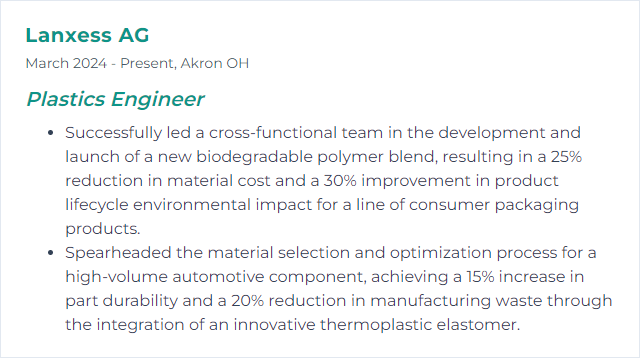
11. Finite Element Analysis (FEA)
A simulation method that predicts how parts respond to loads, heat, vibration, and constraints by breaking geometry into small elements and solving the physics.
Why It's Important
It derisks designs early, trims prototypes, and reveals stress hot spots and failure modes before they become expensive.
How to Improve Finite Element Analysis (FEA) Skills
Accuracy and validation matter most:
Mesh quality: Use refined meshes in critical zones; check aspect ratios and convergence.
Material data: Input temperature- and rate-dependent properties for polymers and blends.
Boundary conditions: Mirror real service conditions, including contacts, constraints, and preload.
Solver strategy: Match solver type to the problem—nonlinear, dynamic, thermal, coupled.
Post-processing: Focus on stress concentrations, deflection, safety factors, and warpage patterns.
Validate: Correlate with tests or trusted benchmarks; adjust models when data disagrees.
Trustworthy simulations shorten the path to robust parts.
How to Display Finite Element Analysis (FEA) Skills on Your Resume
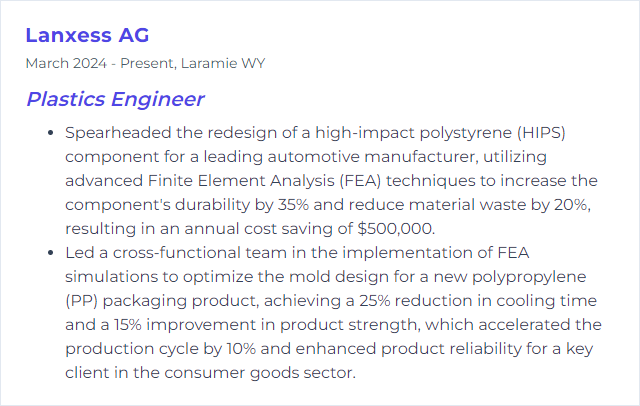
12. 3D Printing
Additive manufacturing that builds parts layer by layer from a digital model, often with polymer filaments, pellets, resins, or powders.
Why It's Important
Lightning-fast prototyping, custom fixtures, and complex geometry with minimal tooling. Lower waste, faster learning cycles.
How to Improve 3D Printing Skills
Push materials, parameters, and design:
Material development: Select or formulate polymers for stiffness, toughness, heat resistance, or biocompatibility.
Process optimization: Tune temperature, speed, cooling, and layer height for strength and surface finish.
Post-processing: Use annealing, vapor smoothing, or UV curing to boost performance and aesthetics.
Hybrid approaches: Combine prints with machining or molding for strength where it matters.
Sustainability: Recycle support material, choose recyclable or bio-based feedstocks, reduce scrap.
Used well, 3D printing collapses timelines and widens design freedom.
How to Display 3D Printing Skills on Your Resume

